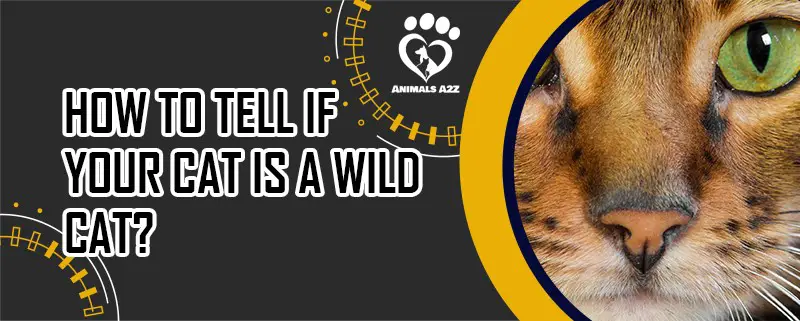Physical and behavioral traits can serve as an indicator of knowing whether your cat is a wild cat. Wild cats are remarkable with their wild appearances, such as their greyish-brown coat, large body size, and robust and muscular build. They are also known for their great hunting skills and being extremely territorial.
Want to be sure how much of a wild cat your cat is? Try a DNA test: read about the best cat DNA tests.
Table of Contents
Unique physical traits of a wild cat
Domestic cats and wild cats are similar in some ways, and they may often mate to become part of the same species (felis catus). But wild cats are, in fact, a different species (felis sivestris).
Size
They differ in physical characteristics. The size is the most remarkable difference between wild and domestic cats. Wild cats are bigger and stronger than domestic cats. A domestic cat normally grows up to 80 cm in length (tail included), while wild cats can reach up to 120 cm in length. The tail of wild cats is longer and thicker than the tail of the domestic cat.
Coat
Another difference is their fur. Wild cats have grey-brown fur with a typical striped or spotted pattern, similar to that of the tabby cats. This gives them the ability to camouflage in their forested habitats. Their fur is soft and short.
However, wild cat coats’ length, color, and pattern vary depending on what region they’re in,
European wild cats (F.s silvestris) have a thick and long coat, suitable for the cold and long winter season. Their thick coats make them appear larger than the other cats in the wild.
Asiatic wild cats (F.s notatus) have a spotted coat combined with a striped pattern fur. Their coat color is usually more yellowish or red with dark spots and stripes.
African wild cats (F.s lybica) are cats that kind of look like domestic cats. They have thinner and shorter fur that suits their extremely hot weather. Their tails are thinner and taper to the tip.
African wild cat habitats have a wide geographic range across the continent. Their coat colors vary with latitude. The color ranges from brown, gray to sandy yellow with dark spots and stripes. They have a distinctive reddish tint on their coat and on the backside of their ears.
*Did you know?
Wild cats, interestingly, have five toes on their front paws and only four toes on their hind paws.
Remarkable behavioral traits of a wild cat
Hunting prey
You prepare food for your cat, but still, you may see them around your house searching, running, and stalking their prey. This is because they were genetically born to hunt and stalk prey.
Hunting and stalking help your cats keep their mind and body strong and healthy in an environment that can easily become unstimulating for them.
If you want to activate your cat’s hunting instincts, provide them toys that imitate the movements of real prey. And if you have a really high prey-driven cat, mental stimulation might be needed. You can try providing them battery-operated toys or you can also add a food puzzle into their meal routine.
Seeking fresh water
If your cat comes running every time you turn on the sink or any faucet, this means that they might have a wild cat personality of having an affinity to water.
If you’ve noticed that they didn’t drink the water you put in their water bowl, the cat’s instinct might be telling them that the stagnant bowl of water could be contaminated; that’s why they didn’t drink it. They might prefer fresh running water.
Usually, cat owners place their cat’s food and water bowls next to each other. They don’t realize that this might go against a cat’s natural instinct to keep food and water separate.
If your cats prefer fresh, running water, you may try a circulating water fountain for them. This will encourage them to drink more-without you having to leave the faucet running.
Marking their territory
You may see your cat scratching your sofa or chair at home, but this doesn’t mean that they want to destroy it. Animals like cats have their own way of communication, like scratching. They scratch to give you and/or other cats a message.
They also leave visual marks on visible areas in your house for everyone to know that this is their territory.
Aside from scratching and leaving visual marks, you may not know cat paws have hidden scent glands. They also use their scent glands to mark their territory. Every time cats scratch a post or chair at your house, they also leave their scent on it, claiming it as their turf.
These pheromones are undetectable to our human noses but are detectable to other cats or animals in the home. This way, other cats and animal pets will be able to sniff out the message that “this is my territory,” “this is my house.”
Tactile greetings
One way cats greet each other is through tactile greeting or tactile communication. It’s used by mother cats and their kittens. Males and females also use this type of greeting during the mating season. This is used often by social species such as lions and domestic cats. This tactile greeting includes chinning and allorubing.
Chinning
Chinning is a cat’s behavior where they brush their chins, lips, or cheeks against allies or friends. These parts of a cat have scent glands on them, which can make pleasant for the other cat.
Allorubbing
It refers to a full-body greeting of cats that they nudge, push and rub against each other, and often gently head-butt each other. If you’ve seen your cats rubbing or pushing each other, they were allorubbing.
Frequently asked questions about wild cats
Can a wild cat become a house pet?
Not all wild cats can be house pets. There are restrictions in some states regarding having a wild cat as a pet. The first reason is that wild cats are wild, and they are not used to people, which makes it hard for them to be tamed and domesticated.
Next is the wild cat’s need for personal health care and breeding because vets and other cat experts have not done enough tests and research about them.
Do wild cats meow at humans?
Domestic cats meow to communicate with humans, but these felines don’t make this sound to other animals. On the other hand, wild cats don’t meow as much as domesticated cats. However, wild cats can make sounds like purring, snarling, chirping, and hissing to express their feelings or communicate with other wild cats.
Do wild cats attack domestic cats?
Wild cats are unlikely to attack domestic cats. This is because of their vastly different habitats and behavioral patterns. These two cat breeds rarely cross paths. Domestic cats are usually active during daytime, while wild cats are nocturnal.
The bottom line
Knowing the wild cat’s distinctive physical appearance and behavior are good ways to distinguish if your cat has wild cat blood in it. However, if you’ve learned and checked all the things listed above and still, you’re not sure if your cat is a wild cat, then the next step is to trust the experts. You might want to consult a reputable breeder or a vet in your area or have your cat take a DNA test to confirm your feline friend’s breed.


